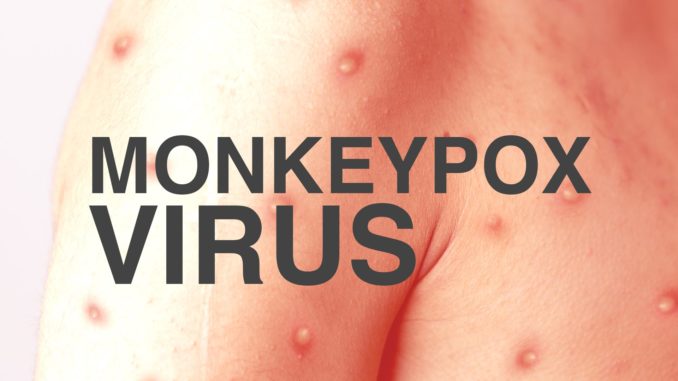
Table of Contents
What is Monkeypox?
- Monkeypox is an illness caused by monkeypox virus.
- Monkeypox is a rare disease caused by infection of monkey pox virus.
- Monkeypox is a member of the Orthopoxvirus virus family, which also contains smallpox and cowpox viruses.
- Monkeypox a viral zoonotic infection, meaning that it can spread from animals to people.
- Monkeypox can also be passed from one individual to another.
- The Monkeypox virus was named after these monkeys, who were the first to be infected with it.
Why is the disease called Monkeypox?
The disease is called monkeypox because it was first identified in colonies of monkeys kept for research in 1958. It was only later detected in humans in 1970.
Key Facts
- Monkeypox is normally a self-limiting condition, with symptoms lasting between two and four weeks. Severe cases are possible.
- The case fatality ratio of Monkeypox is approximately 3–6% in recent years.
- Monkeypox is transmitted to humans through close contact with an infected person or animal, or through contact with contaminated material.
- Monkeypox is a viral zoonotic disease that is predominantly prevalent in tropical rainforests in Central and West Africa, but it can also be found elsewhere.
- Monkeypox resembles smallpox, a related orthopox virus infection that was declared eradicated worldwide in 1980; however, monkeypox is less contagious and causes less severe illness than smallpox.
- Vaccines used in the smallpox eradication campaign were also effective against monkeypox.
- Newer vaccines have been developed, one of which has been approved for the prevention of monkeypox.
Causes of Monkeypox
- Monkeypox is caused by the Monkeypox virus, which is a member of the orthopoxvirus family.
Transmission of Monkeypox virus
- Monkeypox can be transmitted to humans through a bite from an infected animal or direct contact with the animal’s lesions or bodily fluids.
- The virus can be passed from person to person in the following ways:
- prolonged, face-to-face contact with the infectious rash, scabs, or body fluids respiratory secretions during intimate physical contact, such as kissing, hugging, or sex, touching items (such as clothing or linens) that previously touched the infected rash or body fluids
- The virus can be passed from a mother to her fetus through the placenta.
Symptoms of Monkeypox
- Fever
- Headache
- Muscle aches and backache
- Swollen lymph nodes
- Chills
- Exhaustion
- A rash that occurs on the face, within the mouth, and other regions of the body, such as the hands, feet, chest, genitals, or anus, and can resemble pimples or blisters.
- Before entirely healing, the rash passes through several stages. This process can take several weeks to complete.
- A rash may appear first, followed by subsequent symptoms in some cases. Some people merely get a rash.
Risk/Vulnerable Groups for Monkeypox
People at higher risk of disease or complications include-
- Pregnant women
- Children
- Immunocompromised persons
Diagnosis of Monkeypox
- Other rash disorders, such as chickenpox, measles, bacterial skin infections, scabies, syphilis, and medication-related allergies, must be examined in the clinical differential diagnosis.
- Lymphadenopathy can be used to identify monkeypox from chickenpox or smallpox during the prodromal stage of sickness.
- Because of its precision and sensitivity, the polymerase chain reaction (PCR) is the primary laboratory test.
Preventive Measures of Monkeypox
- Avoid contact with animals that may have been infected with the virus (including animals that are sick or that have been found dead in areas where monkeypox occurs).
- Keep infectious patients separate from individuals who could become infected by touching any materials that have come into contact with a sick animal, such as bedding.
- Wash your hands thoroughly after coming into contact with infected animals or humans. Two examples are washing your hands with soap and water or using an alcohol-based hand sanitizer.
- Use personal protective equipment (PPE) when caring for patients.
WHO suggest following ways for prevention of Monkeypox
- The main prevention strategy for monkeypox is to raise public knowledge of risk factors and educate individuals about the steps they may take to decrease their exposure to the virus.
- Reducing the risk of human-to-human transmission
- Reducing the risk of zoonotic transmission
- Preventing monkeypox through restrictions on animal trade
Treatment of Monkeypox
- Currently, no treatment is available for monkeypox.
- Symptoms of Monkeypox normally resolve on their own without the need for treatment.
- If necessary, medication for pain (analgesics) and fever (antipyretics) can be used to relieve the symptoms.
- Monkeypox clinical therapy should be properly adjusted in order to reduce symptoms, manage complications, and minimize long-term consequences.
- A person needs to take good food, stay hydrated and get enough sleep.
- People with monkeypox should avoid scratching their skin and take care of their rash by cleaning their hands before and after touching lesions and keeping skin dry and uncovered
- Secondary bacterial infections should be treated according to the instructions. The European Medicines Agency (EMA) approved tecovirimat, an antiviral drug developed for smallpox, for monkeypox in 2022 based on findings from animal and human research. It isn’t widely available yet
- Smallpox immunization is about 85 percent effective in preventing monkeypox, according to several observational studies. As a result, earlier smallpox vaccination could lead to a lesser illness.
WHO response for Monkeypox
- In affected countries, WHO assists Member States with monkeypox surveillance, readiness, and outbreak response efforts.
References and For More Information
https://www.who.int/news-room/fact-sheets/detail/monkeypox
https://www.cdc.gov/poxvirus/monkeypox/about.html
https://www.nhs.uk/conditions/monkeypox/
https://publichealthupdate.com/who-working-closely-with-countries-responding-to-monkeypox/
https://www.medicinenet.com/script/main/art.asp?articlekey=147142
https://www.researchgate.net/publication/258043776_Human_Monkeypox
https://www.thelancet.com/pdfs/journals/laninf/PIIS1473-3099%2822%2900228-6.pdf